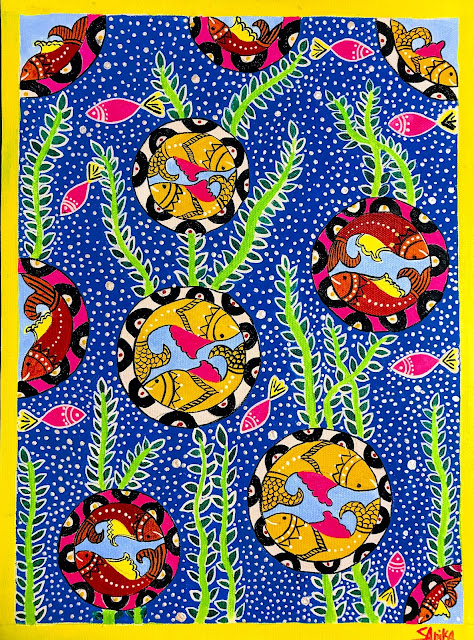Your Story: Sarika Parihar and Madhubani Art
Every artist makes a choice about an art form that he or she would like to pursue seriously. For me it had to be Madhubani because this art form stole my heart right away and I knew this is what I wanted to create. The liveliness and vibrant colors used in this art form would catch anyone’s attention. Madhubani paintings take me back to my roots and remind me of my culturally rich India.
Madhubani art is an incredibly exclusive art form as the artist does not use any subject or stencil but uses his instincts and imagination. This art form doesn’t force you to follow or copy any pattern or make an exact replica of any object, instead it gives you complete freedom to imagine and create anything keeping the soul of Madhubani intact. One has to just create figures which are prominently outlined, have big bulging eyes and a pointed nose. Isn’t that exciting?
Re-discovery: In the year 1934, when Bihar was hit by a massive earthquake, a British colonial officer on duty of inspection of destruction chanced upon these paintings on the interior walls of houses. He was so amazed to see these paintings that later in the year 1949, he brought these paintings to public attention by publishing them in a news journal. This is when this ancient art form was noticed by the world.
History: Madhubani is 2,500 year old art form dates back to the days of Ramayana, when king Janak asked his artists to paint the wedding ceremony of his daughter Sita and Rama. These paintings were usually created by women on the walls and floors of their homes during festivals or other special occasions. Originally these paintings were made using fingers, twigs, brushes, nib pens or kalam using natural dyes like charcoal, soot, turmeric, sandalwood and extracts from leaves and flowers.
Madhubani paintings always depict humans and their association with Mother Nature. They also take inspiration from mythology. Natural elements like the sun, the moon and flora and fauna are widely used. The paintings portray scenes of royal courts, wedding rituals, festivals or any other social events like Durga Puja. No blank spaces are left and the borders are adorned with different geometric patterns like lines, circles and triangles and floral patterns.Madhubani art is an incredibly exclusive art form as the artist does not use any subject or stencil but uses his instincts and imagination. This art form doesn’t force you to follow or copy any pattern or make an exact replica of any object, instead it gives you complete freedom to imagine and create anything keeping the soul of Madhubani intact. One has to just create figures which are prominently outlined, have big bulging eyes and a pointed nose. Isn’t that exciting?
Re-discovery: In the year 1934, when Bihar was hit by a massive earthquake, a British colonial officer on duty of inspection of destruction chanced upon these paintings on the interior walls of houses. He was so amazed to see these paintings that later in the year 1949, he brought these paintings to public attention by publishing them in a news journal. This is when this ancient art form was noticed by the world.
There are 5 types of Madhubani art :-
- Bharni
- Katchni
- Tantrik
- Godna
- Kohbar








Comments
Post a Comment